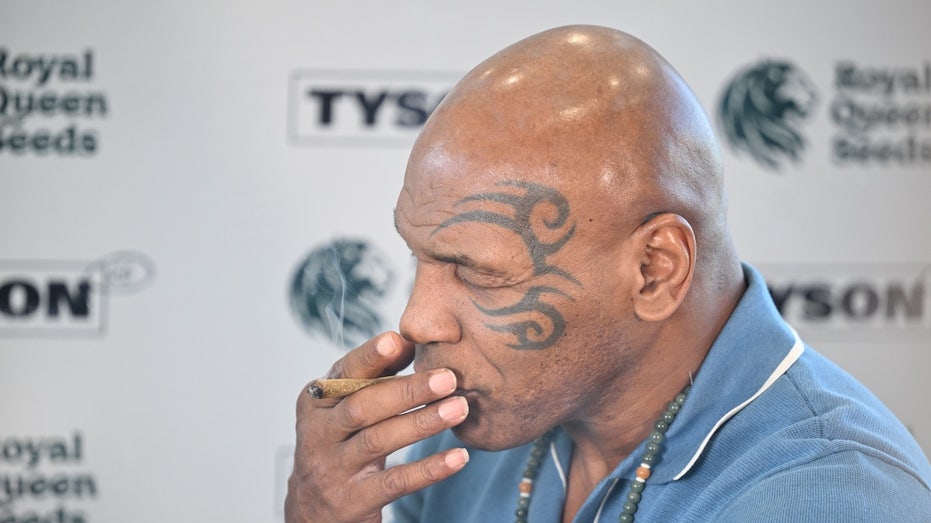EXCLUSIVE: A coalition of sports stars and entertainers have sent a letter to the White House urging President Donald Trump to enact cannabis reform.
The group is headlined by boxing legend Mike Tyson, NBA superstar Kevin Durant, former NBA star Allen Iverson, former boxer Roy Jones Jr., former Dallas Cowboys star Dez Bryant, former NFL star Antonio Brown, and former NFL player and prominent cannabis advocate Ricky Williams.
Williams' name appears twice on the list of signees.
CLICK HERE FOR MORE SPORTS COVERAGE ON FOXNEWS.COM
The group labels itself the "Coalition of Athletes and Entertainers Supporting President Trump’s Policy Objectives."
The letter highlights three main points in their proposed reform: Clemency for "nonviolent" marijuana offenses, support for marijuana rescheduling and ending "discriminatory banking practices."
The first point in the letter points out Trump's previous pardon of music producer Weldon Angelos, who was sentenced to 55 years in prison in November 2004 for marijuana charges. Angelos was released in 2016 and then pardoned by Trump in December 2020. The letter also criticized former President Joe Biden for a lack of action on addressing marijuana-related incarcerations.
"Today, people continue to serve lengthy federal sentences for conduct that is now legal in most states – which makes their continued incarceration not only cruel but absurd. After making sweeping promises to voters in 2020, former President Biden failed to deliver on his pledge to address marijuana-related injustices. Not only did he leave office without commuting the sentences of those incarcerated for marijuana, but in one of his final acts, he denied nearly every pending marijuana-related clemency application," the letter states.
"This betrayal only underscores the urgent need for bold leadership, we believe, and represents an opportunity to correct glaring disparities as part of your Administration’s ongoing push for criminal justice reform."
The second point in the letter urges Trump to reclassify the drug from a Schedule I substance to a Schedule III. The difference in the respective schedules, which are determined by the Drug Enforcement Agency (DEA), determines how drugs are viewed in terms of their potential for abuse vs. medical application.
Schedule I substances have a high potential for abuse and have no accepted medical use in the U.S. They also have a high potential for severe psychological and/or physical dependence.
Schedule III substances have a moderate to low potential for physical and psychological dependence compared to Schedule I and II drugs, and they have accepted medical use in the United States.
"Marijuana’s current classification as a Schedule I substance is scientifically outdated, economically detrimental, and at odds with modern medical understanding," the letter states. "Rescheduling marijuana would harmonize federal law with state policies, promote innovation, encourage research, and drive economic growth."
The final point in the letter arguing against "discriminatory banking practices" points out that Trump has been opposed to a previous U.S. initiative called "Operation Choke Point," which investigated banks and the business they did with firearms dealers, payday lenders and other companies that, while operating legally, were said to be at a high risk for fraud and money laundering.
The group argued marijuana businesses have also been affected by that initiative and other banking practices.
"State-legal cannabis operators, including many of us, have also been unjustly denied banking services despite full compliance with state law," the letter read. "Despite operating legally in 40 states, employing over 450,000 Americans, and generating more than $35 billion annually, these businesses face unjust barriers to banking services, and their employees struggle to obtain mortgages from traditional lenders.
"Moreover, cannabis businesses cannot take standard business deductions, leading to effective tax rates often exceeding 85%. While foreign cannabis companies benefit from listings on U.S. exchanges, such as NYSE and NASDAQ, American cannabis operators are unjustly excluded. We fully support your commitment to 'work with Congress to pass common-sense laws, including safe banking,' ensuring fair economic opportunities and equal access to financial services for all American businesses."
The other figures listed on the letter to the White House include former NBA players Steven Jackson, Chris Webber, JR Smith, John Salley and Al Harrington, former NFL players Jim McMahon, Kyle Turley, Champ Bailey, Marvin Washington and Tony Richardson, and former boxers Boyd Melson, Paul Willias and Keith Thurmon.
The entertainment figures on the letter are streamer Adin Ross, rappers Lil Pump and Ralo, and musician Wyclef.
Follow Fox News Digital’s sports coverage on X and subscribe to the Fox News Sports Huddle newsletter.



